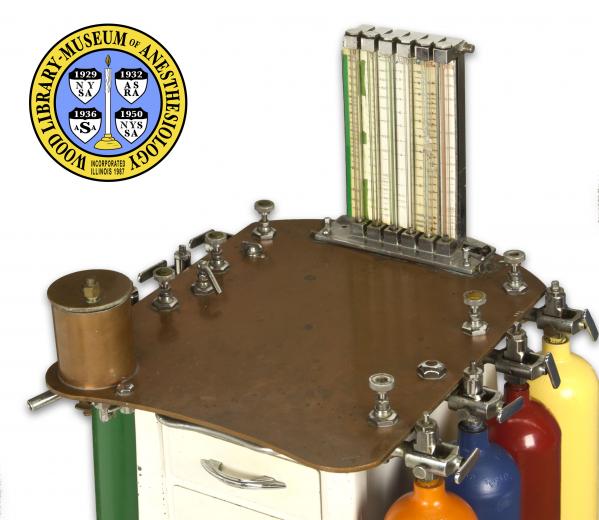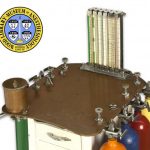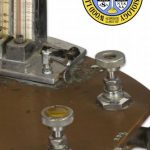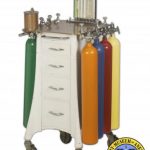Morris Copper Kettle
In 1847, English physician John Snow (1813-1858) described the relationship between temperature and the saturation of ether vapor. This marked the first major milestone in the attempt to control the strength of anesthetic vapor administered to patients. Although small improvements were steadily introduced, throughout the late 19th and early 20th centuries the administration of volatile anesthetics relied upon estimation. This changed in 1952 when Dr. Lucien E. Morris (1914-2011) introduced the Copper Kettle vaporizer, the first system to permit very fine control over the concentration of volatile anesthetics.
The working prototype seen here, built in 1948, is based on the Foregger Texas Model. The table top is made of copper; later models had a stainless-steel table top. The Copper Kettle vaporizer introduced a significant improvement in anesthesia machine design and performance. For the first time the anesthesiologist could precisely control the concentration of volatile anesthetic administered to a patient.
Dr. Morris originally designed the vaporizer for the administration of chloroform. Because it worked with any volatile liquid, it was soon used to administer ether, and later halothane. Effective and safe use of the system required thoughtful attention and a strong understanding of the math and science behind the machine.
Catalog Record: Morris Copper Kettle
Access Key: aiyb
Accession No.: 1993-02-18-1 A
Title: Foregger [Texas model with prototype copper tabletop and copper kettle / vaporizer and circuit designed by Lucien E. Morris].
Author: Morris, Lucien E. (Ellis).
Corporate Author: Foregger Company.
Title variation: Not Applicable
Title: Experimental model with prototype copper kettle vaporizer.
Title variation: Alt Title
Title: Texas model with prototype copper table top and copper kettle.
Title variation: Alt Title
Title: Prototype Morris copper kettle.
Publisher: [Roslyn Heights, N.Y.] : Foregger, [1948?].
Physical Description: 1 anesthesia machine : copper, steel, iron, brass, rubber, glass, paint ; 121 x 57 x 58 cm.
Subject: Anesthesia Machines.
Subject: Chloroform.
Subject: Ether, Ethyl.
Subject: Oxygen.
Subject: Nitrous Oxide.
Subject: Cyclopropanes.
Subject: Halothane.
Note Type: General
Notes: Title based on markings on objects, 2006 article by the designer (p. 882 in
particular), and Foregger equipment catalogs. Date of “late summer 1948”
appears in Morris, “Copper kettle revisited”, 2006, p. 882.
Note Type: Citation
Notes: Foregger Company, Inc. Catalog No. 8. Foregger: Roslyn, N.Y.; 1942:16-17.
Note Type: Citation
Notes: Foregger Company, Inc. Catalog No. 11. Foregger: Roslyn, N.Y.; 1952:46.
Note Type: Citation
Notes: Morris LE. Copper kettle revisited. Anesthesiology. 2006;104(4):881-884.
Note Type: Citation
Notes: Morris LE. A new vaporizer for liquid anesthetic agents. Anesthesiology.
1952;13(6):587-593.
Note Type: Citation
Notes: Sands RP, Bacon DR. The Copper Kettle: A historical perspective. J Clin
Anesth. 1996;8(6):528-532.
Note Type: Physical Description
Notes: Cabinet style anesthesia machine with copper tabletop; This description is
based on the perspective of a user facing the front of the device, i.e.
“left” is the user’s left, “right” is the user’s right; The tabletop has
rounded corners and a curved front edge; The cabinet is steel, painted or
enameled in a white or off-white color; Just below the tabletop, above the
drawers, is a handle; Moving from top to bottom, the four drawers increase in
height; The drawers open to the front; Just under the bottom drawer the
cabinet is marked, “FOREGGER”; The legs of the base flare outward, and end in
pivoting wheels; There are three gas cylinder yokes on the left side of the
machine and four are on the right; Each yoke has a corresponding turn-knob
that is labeled; Some of the knobs have a colored cap; The yoke labels on the
left side, from front to back are “FINE O2” green in color, “COARSE O2” green
in color, “O2 ETHER” red and green; On the right from front to back is a
knob without color marked “C3H6”, a dark red knob without markings, an
unmarked knob without color, and lastly an orange knob with three markings,
“AIR N20 C2H4”; On the left side of the tabletop between the two yolks
furthest back is a switch with a butterfly handle; The switch no longer turns
to align with one of two markings on the tabletop, “ON” or “OFF”; Marked on
the right edge of the table top between the last to yokes is, “R30”; On the
left front corner of the tabletop is the prototype copper kettle vaporizer;
In the back of the vaporizer is a window through which the level of liquid
anesthetic in the vaporizer can be seen; A scale indicating the number of
cc’s of liquid is marked on one side of the window; A filling port is located
on the top of the vaporizer; The copper kettle vaporizer measures approx. 14.
5 cm in height with the filling port and 11 cm without; The vaporizer is
approx 9.5 cm in dia.; Just under the left front corner of the tabletop is
the port for gas flowing from the machine, to the patient; Along the back
edge of the tabletop is the flow meter assembly which measures approx 31.5 cm
in height (with base) and 24 cm in width; There are six glass flow meters
backed with individually graduated and colored columns; From left to right
the columns are marked for “O2” in green, “AIR” in black, “N2O” in blue,
“C2H4” in red, and “C3H6” in orange (There are three columns for O2); The
glass of the flow meter for C2H4 is broken; On the right side of the cabinet
just under the tabletop is a sticker with the following markings, “WISCONSIN
GENERAL HOSPITAL [new line] Div. 10 [space] Dept 17 [new line] Class 16
[space] Item 137”; On the back of the cabinet handwritten in black ink or
paint is the number 10; A grounding chain attached to the right front and
left back legs hangs underneath the cabinet, just skimming the floor.
Note Type: Reproduction
Notes: Photographed by Mr. William Lyle, Sept. 23, 2010; In order to present an
image of the apparatus in the best state possible, this example was
photographed with gas cylinders or tanks from the Parts Collection.
Note Type: Acquisition
Notes: Donated to the WLM by Ted Smith, MD. Morris, in “Copper kettle revisited”,
2006, p. 882, states: “The first manufactured apparatus to include some of
the design principles of this new vaporizing system was made by the Foregger
Company of New York, New York, and delivered to us at Wisconsin [University]
in the late summer of 1948. This early prototype is now at the Wood Library
Museum in Park Ridge, Illinois.”
Note Type: Historical
Notes: Research by English physician John Snow (1813-1858) published in 1847,
describing the relationship between temperature and the saturation of ether
vapor, marked the first major milestone in the attempt to control the
strength of anesthetic vapor administered to patients. The understanding
that the concentration of ether is dependent upon temperature influenced the
design of ether inhalers, including Snow’s own tin and copper inhalers.
However, until Dr. Lucien E. Morris designed the copper kettle and redesigned
the anesthesia gas circuit, control over vapor concentration continued to be
based on very rough estimates (Sands & Bacon, 1996).
Note Type: Historical
Notes: Earlier anesthesia machines included metered flow of nitrous oxide (N2O) and
oxygen (O2). As well there were machines that incorporated the delivery of
N2O and O2 with volatile liquid anesthetics, such as chloroform and ether,
but the amount of volatile anesthetic delivered to the patient was estimated
The copper kettle design was the first vaporizer and anesthetic delivery
circuit to permit very fine control over the concentration of administered
volatile anesthetic (Sands & Bacon, 1996).
Note Type: Historical
Notes: The copper kettle was designed with chloroform administration in mind, but
because it worked with any volatile liquid, it was soon used to administer
ether, and later halothane (Morris, 2006). Dr. Morris’s system included three
major elements not present in earlier machines. The first was the addition of
separately metered flow for the gas directed to the vaporizer. The customary
use of separate flow meters for other gases, such as oxygen, nitrous oxide,
and cyclopropane, was preserved. This circuit design allowed the
anesthesiologist to know precisely what volume of gas was flowing through the
vaporizer (Morris, 1952). The vapor was mixed with the other gasses in a
mixing chamber just prior to delivery to the patient. The copper construction
for the vaporizer is the second unique element. Copper was chosen for its
superior heat conductivity (Morris, 1952). Early models included a copper
tabletop to further improve thermostability. This was found to be too
expensive and was discontinued (Sands & Bacon, 1996). The final unique design
element was the incorporation of a specially designed disk that caused the
carrier gas to move through the volatile anesthetic in very fine bubbles.
This increased the surface area for liquid-to-gas interface (Morris, 1952).
The copper construction and fine bubble-through produced reliable vapor
saturation.
Note Type: Historical
Notes: The anesthesiologist determined the amount of anesthetic being delivered to
the patient with the use of calculations based on the physics of the vapor
pressure for the particular anesthetic being administered. For this reason,
effective and safe use of the system required the anesthesiologist to have a
strong understanding of the math and science behind the machine. As well,
because the calculations varied with the anesthetic in use, the
anesthesiologist needed to perform the calculations with thoughtful attention
(Morris, 2006 ; Sands & Bacon, 1996).




